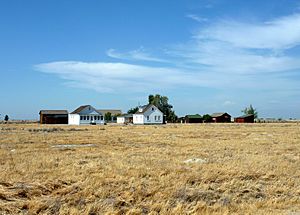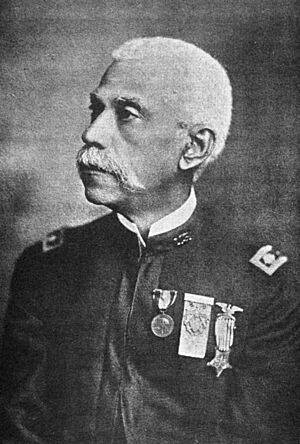Allensworth, California facts for kids
Quick facts for kids
Allensworth, California
|
|
|---|---|

Allensworth's restored buildings now occupy Colonel Allensworth State Historic Park.
|
|

Location in Tulare County and the state of California
|
|
| Country | United States |
| State | California |
| County | Tulare |
| Founded | 1908 |
| Named for | Allen Allensworth |
| Area | |
| • Total | 3.10 sq mi (8.04 km2) |
| • Land | 3.10 sq mi (8.04 km2) |
| • Water | 0.00 sq mi (0.00 km2) 0% |
| Elevation | 213 ft (65 m) |
| Population
(2020)
|
|
| • Total | 531 |
| • Density | 171.18/sq mi (66.09/km2) |
| Time zone | UTC-8 (Pacific (PST)) |
| • Summer (DST) | UTC-7 (PDT) |
| ZIP code |
93219
|
| Area code | 661 |
| FIPS code | 06-01010 |
| GNIS feature ID | 2585402 |
Allensworth is a small town in Tulare County, California. It was started in 1908 by Allen Allensworth. This town was special because it was the first in California to be founded, paid for, and run by African Americans.
Today, the original town area is known as Colonel Allensworth State Historic Park. In 2020, about 531 people lived in Allensworth. The United States Census Bureau calls Allensworth a "census-designated place" (CDP) for counting purposes.
Allensworth is located at an elevation of about 213 feet (65 meters). This is the same height as the shore of the huge Tulare Lake when it was full. The town uses the ZIP Code 93219 and the area code 661.
Contents
History of Allensworth

On June 30, 1908, a special group was formed called the California Colony and Home Promoting Association. It was led by Colonel Allen Allensworth, a clergyman, and Professor William Alexander Payne. They were joined by other Black men: John W. Palmer, William H. Peck, and Harry A. Mitchell.
This group bought 20 acres of land to create a town for Black soldiers and their families. The land was near a train stop called "Solita." Their goal was to build a community where African Americans could control their own lives and futures.
Early Growth and Success
Colonel Allensworth's good reputation attracted many people to the new town. People from all over the country bought land, sometimes without even seeing it, to support this important effort. In the early 1900s, Allensworth grew quickly. By 1910, it had California's first school district for African Americans.
Between 1912 and 1915, Allensworth was at its best. Newspapers like The New York Age and the California Eagle wrote about its growth. The California Eagle even pointed out that "not a single white person" was involved in running the town. The Los Angeles Times called Allensworth an "ideal Negro settlement."
By 1914, the town had a schoolhouse, a courthouse, a Baptist church, a hotel, and a county library.
Challenges and Changes
In 1914, Allensworth faced several problems. The Santa Fe train line moved its stop away from Allensworth to a nearby town called Alpaugh. This made it harder for people and goods to get to Allensworth.
In September 1914, Colonel Allensworth sadly died in Monrovia, California, after being hit by a motorcycle. His death was a huge loss for the town. Allensworth also suffered from a severe drought. Water was sent away from the town, which hurt their crops.
Despite these difficulties, records from 1915 showed that many people still lived and worked there. There were farmers, storekeepers, carpenters, and nurses, showing that the town was still active. However, many residents started to leave after World War I.
In 1966, there were plans to tear down the town of Allensworth. This was because of problems with the water supply.
Allensworth's Lasting Legacy
In 1974, Allensworth was recognized as a state park. This helped to save its history. In 1976, the Colonel Allensworth State Historic Park was officially created. This was largely thanks to Cornelius Ed Pope. Many of the old buildings from 1908-1918 have been fixed up in the town center.
The park holds special events throughout the year to share its history. Thousands of visitors come from all over California to learn about this unique place. A 2022 movie called Allensworth also features the restored buildings.
Geography and Nature
Allensworth is located on what used to be the eastern edge of Tulare Lake. This lake was once the largest in the U.S. outside of the Great Lakes. It was home to many Native American people, elk, and millions of birds. Today, only a tiny part of Tulare Lake remains because its natural waterways were changed.
Just north of Allensworth is the Pixley National Wildlife Refuge. This large area of grassland and wetlands is managed by the U.S. Fish and Wildlife Service. Every winter, from November to March, thousands of sandhill cranes visit this refuge. You can also see other birds like Red-tailed hawks and sometimes Burrowing owls. Pacific pond turtles, which were once important for fishing in Tulare Lake, also live here.
Next to the town is the Allensworth Ecological Reserve. This area is home to the endangered San Joaquin kit fox.
The U.S. Census Bureau says that Allensworth covers about 3.1 square miles (8.0 square kilometers) of land.
Population Information
| Historical population | |||
|---|---|---|---|
| Census | Pop. | %± | |
| 2010 | 471 | — | |
| 2020 | 531 | 12.7% | |
| U.S. Decennial Census | |||
The 2010 United States Census reported that Allensworth had 471 people. About 33.5% of the people were White, and 4.7% were African American. A large number, 92.6%, were of Hispanic or Latino background.
The census also showed that all 471 people lived in homes. There were 115 households in total. Many households (60%) had children under 18 living there. The average household had about 4.10 people.
The population included many young people. About 39.7% were under 18 years old. The median age in Allensworth was 23.4 years. This means half the people were younger than 23.4 and half were older.
Most homes were either owned by the people living in them (48.7%) or rented (51.3%).
Education
The Allensworth School District has one school: Allensworth Elementary School. This school serves students from kindergarten through 8th grade.
Images for kids
-
Allensworth's restored buildings now occupy Colonel Allensworth State Historic Park.
-
Location in Tulare County and the state of California
-
The town was named for and in part established by Col. Allen Allensworth, a chaplain of the United States Army who escaped slavery during the Civil War.
See also
 In Spanish: Allensworth para niños
In Spanish: Allensworth para niños





